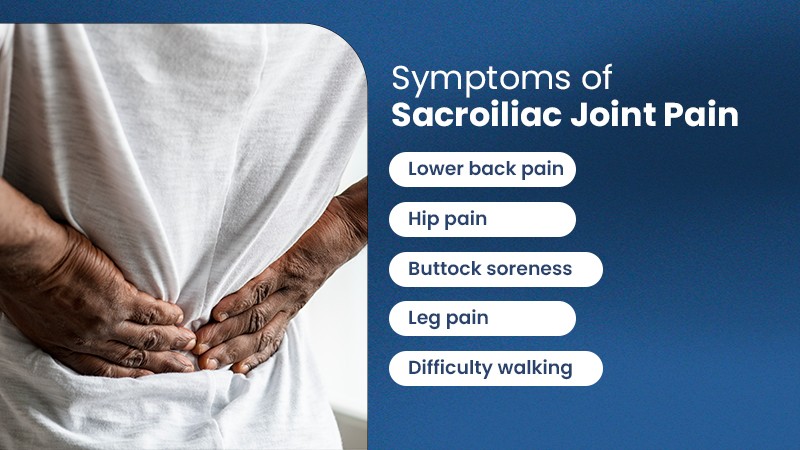Sacroiliac Joint Pain

Sacroiliac Joint Pain: Understanding and Managing the Ache
SI joint pain, also known as sacroiliac joint pain, is a common ailment that can significantly impair daily activities and create substantial discomfort. This joint, which is where the sacrum and pelvis meet at the base of the spine, is essential for allowing movement and sustaining the weight of the body. This joint can develop inflammation or malfunction, which can cause a variety of incapacitating symptoms.
Understanding the Sacroiliac Joint
The intricate junction that joins the spine to the pelvis is known as the sacroiliac joint, or SI joint. It is composed of two major bones: the sacrum and the ilium. Strong ligaments hold these bones together, giving the joint stability. The SI joint plays a vital role in weight distribution, shock absorption, and transferring forces between the upper and lower body.
What are the Symptoms of Sacroiliac Joint Pain
It’s critical to identify the signs of SI joint discomfort in order to get the right care. Although the pain’s location and intensity can vary, some typical signs are as follows:

Lower back pain: Lower back discomfort, usually on one side, that is dull and painful is a common symptom of SI joint pain.
Hip pain: Moreover, the discomfort may extend to the hip area, making it difficult to engage in activities that involve hip movement.
Buttock soreness: Another typical SI joint dysfunction symptom is buttock soreness.
Leg pain: The pain may occasionally travel down the leg, resembling sciatica symptoms.
Difficulty walking: Further, the pain can make walking, standing, or sitting for extended periods uncomfortable or challenging.
It’s crucial to remember that these symptoms might mimic those of other illnesses, so seeking a professional diagnosis is necessary. As a result, you will know if you need treatment.
Causes of Sacroiliac Joint Pain
Several factors can contribute to the development of SI joint pain:
Injury: Trauma to the pelvis or lower back can damage the SI joint ligaments, leading to instability and pain.
Pregnancy and childbirth: Additionally, hormonal changes and the increased stress on the pelvic joints during pregnancy can contribute to SI joint dysfunction.
Arthritis: The SI joint may become painful and stiff due to conditions such as osteoarthritis or ankylosing spondylitis.
Improper lifting: Furthermore, incorrectly lifting heavy objects can put excessive strain on the SI joint, leading to inflammation.
Repetitive strain: Finally, activities that involve repetitive bending, twisting, or lifting can irritate the joint.
What Kind of Doctor Should I See to Treat Sacroiliac Joint Pain?
It’s critical to get medical help if you’re having symptoms of sacroiliac joint discomfort so that you can receive the right diagnosis and treatment. You should speak with a medical expert who specializes in treating musculoskeletal disorders.
A physiatrist, orthopedist, or chiropractor can provide comprehensive care for SI joint pain. These experts possess the knowledge and skills necessary to assess your condition, identify the underlying cause, and suggest the best course of action.
Identification of SI Joint Pain
SI joint discomfort can be difficult to diagnose because its symptoms frequently resemble those of other illnesses. However, healthcare providers use various methods to identify the issue:
Physical examination: A thorough examination of the spine, pelvis, and hips can help identify areas of tenderness and restricted movement.
Imaging tests: In addition, X-rays, MRIs, or CT scans can be performed to evaluate the SI joint’s health and rule out other disorders.
Injections used for diagnosis: Additionally, if the pain is coming from the joint, it may be possible to identify it by injecting a local anesthetic into the SI joint.
Get In Touch With A Pain Specialist Now
Treatment Options for SI Joint Pain
The course of treatment for sacroiliac joint pain is determined by the degree of the condition and its underlying cause. Typical therapy alternatives include the following:
Physical therapy: Stretches and exercises can assist in increasing flexibility, strengthen the core muscles, and lessen pain.
Chiropractic care: Using adjustments and manipulations to the spine and pelvis, SI joint dysfunction can be lessened.
Drugs: In addition, anti-inflammatory prescription medications or over-the-counter pain medicines can aid in the management of pain and inflammation.
Cortisone injections: By injecting corticosteroids straight into the SI joint, acute pain may be momentarily relieved.
Radiofrequency ablation: In this process, the pain impulses coming from the SI joint are destroyed by heat.
Surgery: Nevertheless, physicians may think about performing surgery in extreme situations when non-conservative therapies are failing.
Preventing SI Joint Pain
While it may not be possible to prevent sacroiliac joint pain, adopting certain lifestyle modifications completely can help reduce the risk:
Sustain a healthy weight: Having too much weight strains the SI joint more.
Proper lifting techniques: Additionally, avoid lifting heavy objects improperly to prevent strain on the back and pelvis.
Frequent exercise: Low-impact activities that strengthen the core muscles and increase flexibility include yoga, walking, and swimming.
Optimal posture: Sustaining proper posture lessens strain on the SI joint and aids with weight distribution.
Ergonomic workspace: Additionally, make sure your desk is set up ergonomically to reduce strain on your pelvis and back.
Specific Locations of SI Joint Pain
While the sacroiliac joint is often the culprit behind lower back discomfort, the pain can manifest in various areas. Knowing where the pain is might help reveal important details about the underlying problem.
Lower back pain: This is the most common symptom and is often described as a dull, aching sensation.
Buttock pain: Pain in the buttocks, particularly on one side, is a strong indicator of SI joint involvement.
Hip pain: Furthermore, SI joint dysfunction can radiate hip flexor pain, which results in making it difficult to move the leg comfortably.
Groin pain: In some cases, one may feel pain in the groin region, especially when putting weight on the affected side.
Leg pain: While less common, SI joint pain can sometimes mimic sciatica, causing pain that extends down the leg.
Identifying SI Joint Pain Triggers
Pinpointing activities or positions that exacerbate SI joint pain can aid in diagnosis and management. Common triggers include:
Standing for prolonged periods: Weight-bearing activities can increase pressure on the SI joint. You can also read how standing for long time can cause back pain
Sitting for extended periods: Further, improper posture while sitting can strain the joint.
Lifting big objects: Improper lifting methods might cause the SI joint to experience excessive stress.
Bending and twisting: These movements can irritate the joint and worsen pain.
Step-up or step-down motions: Activities that involve stepping up or down stairs can be challenging with SI joint pain.
The Role of Pregnancy and SI Joint Pain
Pregnancy-related hormonal changes and the increased weight on the pelvic joints can contribute to SI joint dysfunction. During and after pregnancy, many women have lower back and pelvic pain. To alleviate pregnancy-related SI joint pain, it’s essential to consult with a healthcare provider for safe and effective treatment options.
SI Joint Pain and Athletes
Sacroiliac joint pain is more common in athletes who participate in repetitive twisting, jumping, or running sports. Sports like tennis, golf, basketball, and soccer can place a lot of strain on the SI joint. Athletes must have early diagnosis and adequate treatment in order to avoid chronic discomfort and retain performance.
Advanced Treatment Options for Sacroiliac Joint Pain
If standard therapies fail to provide sufficient relief, one could consider more sophisticated solutions:
Sacroiliac joint fusion: In order to stabilize the SI joint, this surgical treatment fuses it.
SI joint implant: Doctors may use an artificial joint implant to replace the damaged SI joint.
Regenerative medicine: Treatments like stem cell therapy and platelet-rich plasma (PRP) injections may aid in promoting healing and reducing inflammation.
The Importance of Core Strength for SI Joint Health
The pelvis and spine need support from a strong core. Exercises that focus on the back and abdominal muscles, as well as the SI joint, can help stabilize it and lessen pain. You can prevent and manage SI joint problems by including core strengthening activities in your program.
Conclusion
Sacroiliac joint pain can be a frustrating and debilitating condition. However, many people can find relief and improve their quality of life with the right diagnosis and treatment. It’s critical to speak with a healthcare provider if you’re having SI joint discomfort symptoms in order to identify the underlying reason and create a suitable treatment strategy. Dr. Faheem Abbasi and the team at New Jersey Pain, Spine & Sports Associates offer comprehensive care for sacroiliac joint pain and can help you find the relief you deserve.
FAQs
What is the best treatment for SI joint pain?
The underlying cause and degree of symptoms determine the optimal course of action for treating SI joint discomfort. A combination of physical therapy, chiropractic care, medications, and lifestyle modifications often proves effective. In severe cases, doctors may consider injections or surgery.
Will my sacroiliac joint pain ever go away?
For many people, appropriate treatment can effectively manage the sacroiliac joint pain. Significant improvement in symptoms and performance is possible, even though complete resolution may not always be achievable.
What does it feel like when your sacroiliac joint is out of place?
When the sacroiliac joint is out of place, it can cause a dull, aching pain in the lower back, hip, or buttock. Certain motions can make the discomfort worse, including standing, walking, or spending a lot of time sitting still. Additionally, you may experience stiffness, difficulty walking, or referred pain down the leg.
